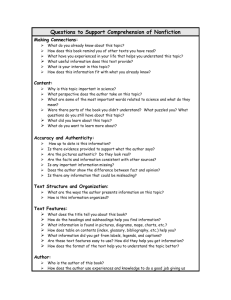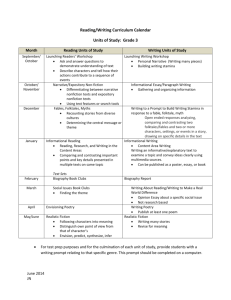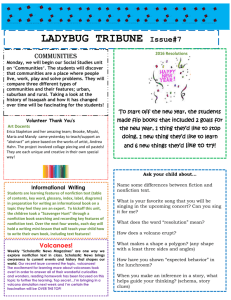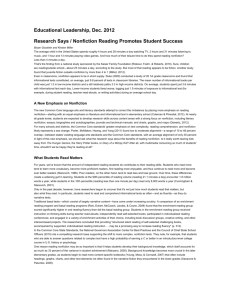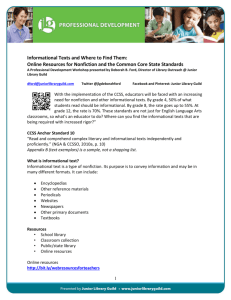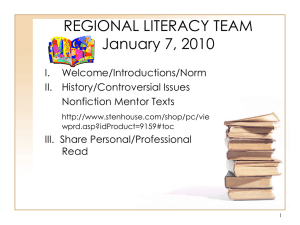Reading Nonfiction Learning Targets
advertisement
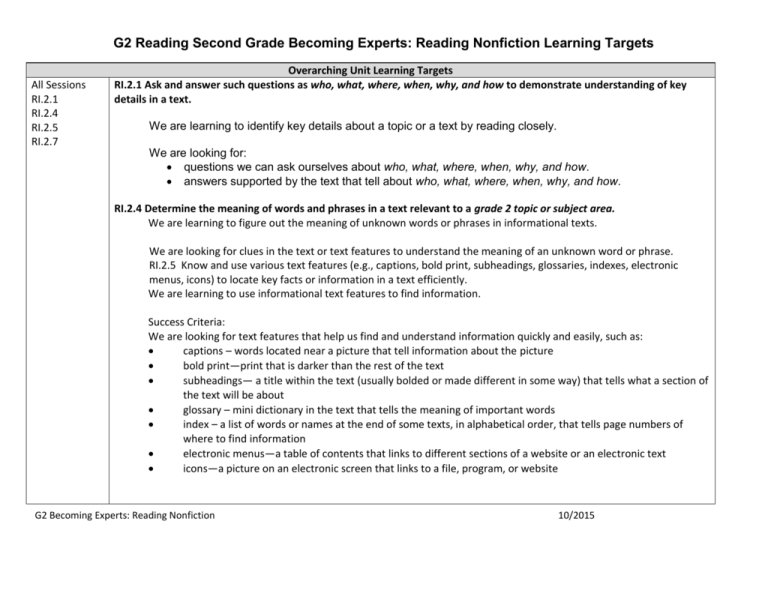
G2 Reading Second Grade Becoming Experts: Reading Nonfiction Learning Targets All Sessions RI.2.1 RI.2.4 RI.2.5 RI.2.7 Overarching Unit Learning Targets RI.2.1 Ask and answer such questions as who, what, where, when, why, and how to demonstrate understanding of key details in a text. We are learning to identify key details about a topic or a text by reading closely. We are looking for: questions we can ask ourselves about who, what, where, when, why, and how. answers supported by the text that tell about who, what, where, when, why, and how. RI.2.4 Determine the meaning of words and phrases in a text relevant to a grade 2 topic or subject area. We are learning to figure out the meaning of unknown words or phrases in informational texts. We are looking for clues in the text or text features to understand the meaning of an unknown word or phrase. RI.2.5 Know and use various text features (e.g., captions, bold print, subheadings, glossaries, indexes, electronic menus, icons) to locate key facts or information in a text efficiently. We are learning to use informational text features to find information. Success Criteria: We are looking for text features that help us find and understand information quickly and easily, such as: captions – words located near a picture that tell information about the picture bold print—print that is darker than the rest of the text subheadings— a title within the text (usually bolded or made different in some way) that tells what a section of the text will be about glossary – mini dictionary in the text that tells the meaning of important words index – a list of words or names at the end of some texts, in alphabetical order, that tells page numbers of where to find information electronic menus—a table of contents that links to different sections of a website or an electronic text icons—a picture on an electronic screen that links to a file, program, or website G2 Becoming Experts: Reading Nonfiction 10/2015 G2 Reading Second Grade Becoming Experts: Reading Nonfiction Learning Targets RI.2.5 Know and use various text features (e.g., captions, bold print, subheadings, glossaries, indexes, electronic menus, icons) to locate key facts or information in a text efficiently. We are learning to use text features to locate information easily. We are looking for: captions—words located near a picture that tell about the picture bold print—print that is darker than the rest of the text subheadings— a title within the text (usually bolded) that tells what a section of the text will be about glossary—mini dictionary in the text that tells the meaning of important words index—a list of words or names at the end of some texts, in alphabetical order, that tells page numbers of where to find information electronic menus—a table of contents that links to different sections of a website or an electronic text icons— pictures on electronic screens that link to a file, program, or website RI.2.7 Explain how specific images (e.g., a diagram showing how a machine works) contribute to and clarify a text. We are learning to explain how specific images (photographs, illustrations, diagrams, charts, graphs, tables, etc.) help us understand information in texts. We are looking for what specific information is gained from the image that helps us understand the author’s words. Session 12-15 Additional Session Learning Targets RI.2.9 Compare and contrast the most important points presented by two texts on the same topic. We are learning to compare and contrast main ideas between two texts on the same topic. We are looking for: how the main ideas between two texts are similar how the main ideas between two texts are different G2 Becoming Experts: Reading Nonfiction 10/2015 G2 Reading Second Grade Becoming Experts: Reading Nonfiction Learning Targets Session 16 RI.2.2 Identify the main topic of a multi-paragraph text as well as the focus of specific paragraphs within the text. We are learning to identify the main ideas of an informational text. We are looking for: the main topic or big idea of an entire text. the main topic or big idea of some paragraphs within a text. RI.2.3 Describe the connection between a series of historical events, scientific ideas or concepts, or steps in technical procedures in a text. We are learning to describe the relationship between individuals, events, and ideas within informational text. We are looking for details that tell how or why historical events, scientific ideas, or steps in technical procedures go together. RI.2.6 Identify the main purpose of a text, including what the author wants to answer, explain, or describe. We are learning to identify the author’s purpose for writing an informational text. We are looking for: what question the author wanted to answer what topic (person, place, or thing) the author wanted to describe what the author wanted to explain about how or why something happened G2 Becoming Experts: Reading Nonfiction 10/2015
